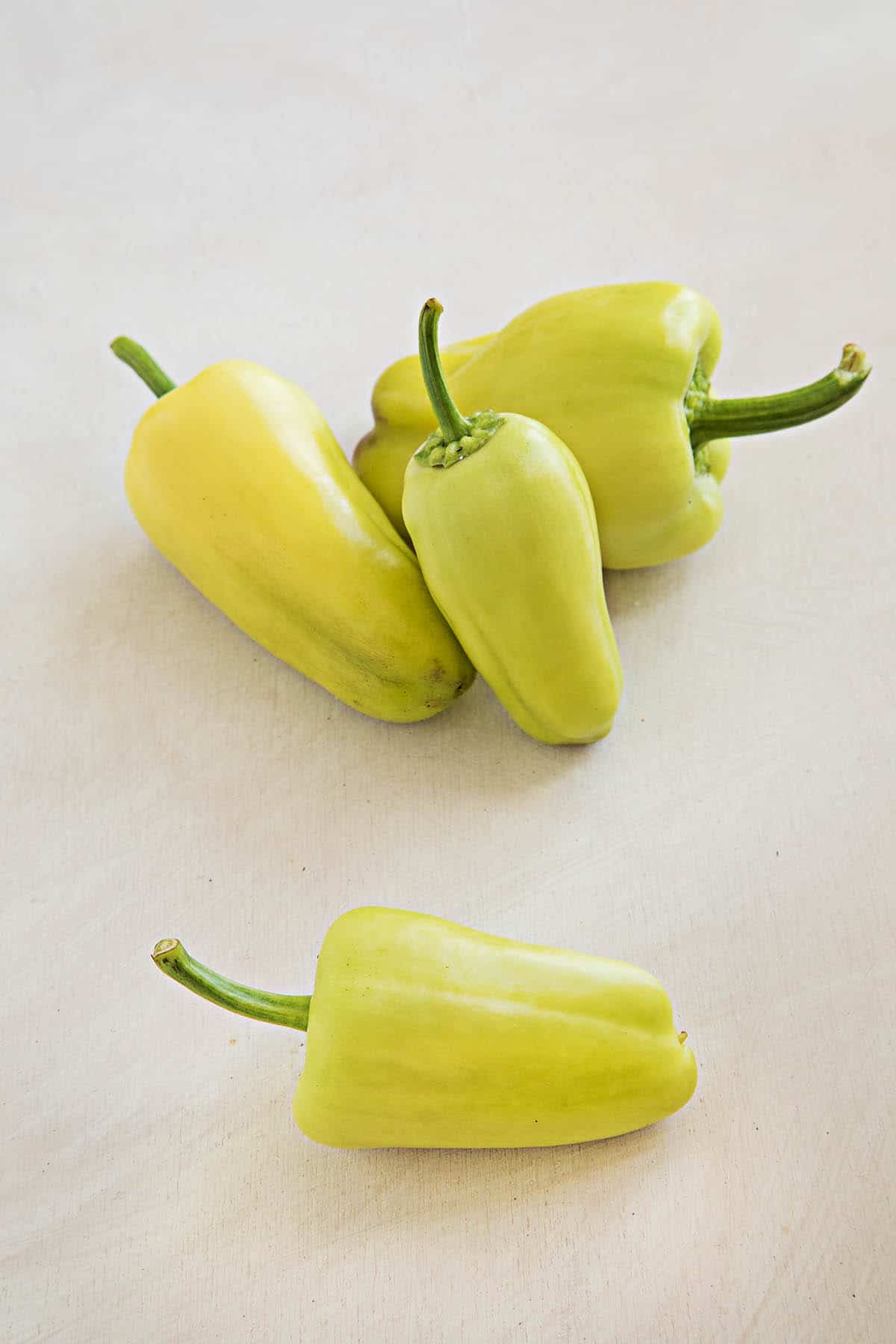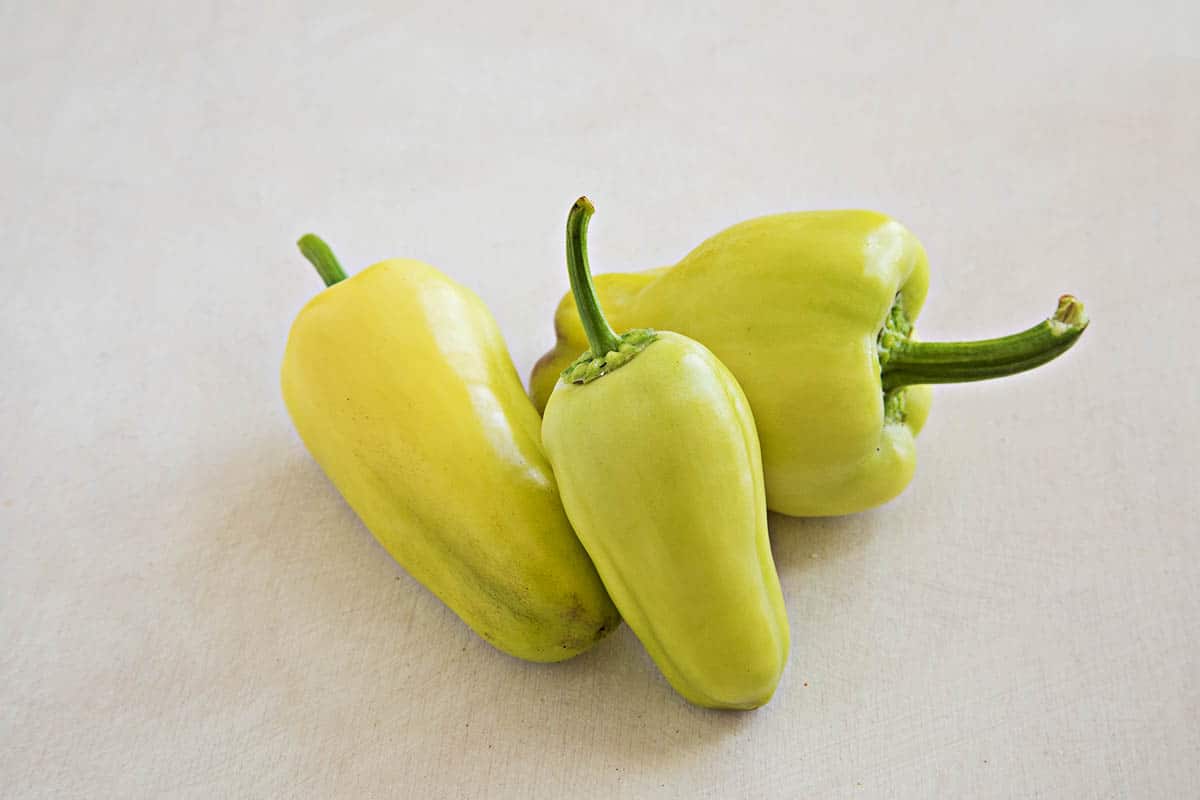The gypsy pepper is a hybrid pepper resulting from a cross between a sweet Italian bull horn pepper and a bell pepper. It was developed by Petoseed, a Southern California company specializing in hybridizing peppers and tomatoes. Learn more about the gypsy pepper at Chili Pepper Madness.

Scoville Heat Units: 0 SHU
Capsicum Annuum
About the Gypsy Pepper
Gypsy peppers are a hybrid pepper developed by Petoseed, a Southern California company specializing in hybridizing peppers and tomatoes. They are a cross between sweet Italian bull horn peppers and bell peppers. These peppers were developed to resist the tobacco mosaic virus, a common plant disease.
They are sometimes referred to as cubanelle peppers. They are popular chili peppers for general home garden growing and cooking, prized for their sweetness and prolific plant production. You'll usually get a lot of peppers from each plant.
The super sweet Gypsy pepper creates a rainbow of color in the garden, as the fruits mature from yellow to orange to red, all at different times on the plant.
Appearance
Gypsy peppers average about 4 inches (10 cm) long by 2 inches (5 cm) diameter, with a tapered shape that is wider at the stem, much like a jalapeno pepper, with thin skin. The flesh starts out as a yellow-green color then matures to a deeper orange-red color. The skin is smooth and firm.
How Hot is a Gypsy Pepper?
The gypsy pepper measures in at 0 Scoville Heat Units on the Scoville Scale, meaning it has no heat. It is a sweet pepper, on par with the popular bell pepper in its complete lack of heat. It is not a hot pepper by any means.
Gypsy Pepper Flavor
Gypsy peppers are known for their sweetness and noticeable crunch, but also for their lack of heat. Because they are a no-heat pepper, their sweet flavor stands out, and they can be used in any number of recipes. The pepper flesh is quite crisp, especially when chilled. These peppers are frequently harvested at any stage of maturity. The younger pods taste a bit more like a green bell pepper with a slight acidity. When mature, the peppers develop more sweetness and nuance.
Eating or Cooking Gypsy Peppers
Because of their sweetness and their crunch, they are delicious when served fresh in salads or with dips. They are also great for frying or stuffing. Many cooks choose to serve them raw. Just slice them up and serve them with a light and refreshing vegetable dip. I enjoy them for general cooking, as part of a simple mirepoix or Cajun Holy Trinity with onions and celery and a bit of garlic. They add great flavor to many dishes.
They do make for good frying peppers, and while they are smaller, you can stuff them for smaller appetizer stuffed peppers. My favorite use for them is general cooking down with onions, celery or carrots and garlic as a flavor base, but I also enjoy them raw. I also used them to make homemade sofrito, which itself is a popular flavor base in Latin American cooking.
Growing Gypsy Peppers
Gypsy pepper plants are easy to grow in your home garden and are quite prolific, with a plant capable of producing 50-100 plants in a single season. You can harvest the pods at any stage of maturity to use in any sort of cooking. The plants are high producers, yielding a large harvest throughout the season. They plants enjoy full sun. At maturity the are about 4 inches with a tapering bottom, similar in shape to a jalapeno, but larger and wider.
My Personal Experience
I have grown gypsy peppers in my own home garden and I can attest that they are truly very productive plants. I received a great yield of sweet peppers when I grew them, all from a single plant. I froze a number of the pods, chopped, for my own general daily cooking. They are easy to grow with typical plant spacing and are fine with full sun or a bit of shade.
I would definitely grow these again in my garden and plan to do so in the future. Very prolific!
Similar Peppers
Gypsy peppers are sweet peppers and can be used where other sweet peppers are called for. Some similar peppers you might consider are:
- Sweet Bell Peppers
- Albino Sweet Pepper
- Italian Sweet Pepper
- Corno di Toro
- Cubanelle Pepper
- Santa Fe Grande
I wouldn't say any of these peppers is a direct replacement for gypsy peppers, but any of these will do for general cooking, even with some slight flavor differences, particularly in the level of sweetness.
Where Can I Buy Gypsy Peppers?
Check out my Chili Pepper Seeds and Plant Resources page to find potential sellers of Gypsy pepper seeds and seedlings. You can also Buy Gypsy Pepper Seeds at Amazon (affiliate link, my friends!). Happy growing!

NOTE: This recipe was updated on 9/22/20 to include new information. It was originally published on 7/25/17.


Carol says
Want to make Sofrito. I've never seen Aji Dulce peppers in any market. What pepper can be used instead? Thank you! I'm glad I have a few Gypsy/Cubanelle sweet pepper plants in my garden!!
Mike Hultquist says
Hi, Carol. You can use those instead. Any peppers from your garden, really. Let me know how it turns out!
Debi says
First year planting these. I’m still confused about knowing when these are ripe. Can they be eaten before they turn red, or am I confusing these with the yellow, orange and red mini sweet peppers? Thank you in advance.
Mike Hultquist says
Debi, you can definitely pick them and enjoy them green, and they are popular this way. You can leave them on the plant longer to ripen to more red and use them then as well. The choice is yours. Very versatile peppers.
Kat says
Since this is a hybrid if I save the seeds from my plant (first time trying to grow these) they will not grow correctly, right? I'd have to order the specialized seeds from a grower?
Thanks. 🙂
Mike Hultquist says
They should grow just fine, Kat, as it is stabilized.
Judith Meyers says
If I save seeds, you said they will grow fine.
1. Does that mean they will grow like the mother plant?
2. What does "stabilized" mean in regard to the seeds and/or plants.
Thank you for your assistance.
Mike H. says
Judith, whether the seeds will grow like the mother plant depends on several factors, including the genetics of the parent plant, whether the seeds are stabilized, etc. Which leads me to your second question. "Stabilized" in this case refers to the process of selective breeding over different generations in order to develop a consistent set of traits. They often refer to stabilized seeds as to "open-pollinated" or "heirloom". So when you grow plants from such stabilized seeds, you can expect them to have more uniform characteristics. And that means more chances to have the new plants resemble the parent plant.
Kreig Williams says
Do you sell mild Hungarian pepper seed too?
Mike Hultquist says
Sorry, we don't sell seeds. Please see the Resources section of the site for sellers.